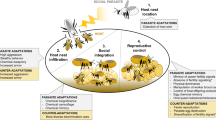Abstract
This article is a primer on social insects, and includes salient features of eusociality, its evolution and characteristics of a few social insects. It introduces William Morton Wheeler’s landmark book “Social Life Among the Insects,” whose centenary year of publication inspired the theme of this special issue of the Journal of the Indian Institute of Science. It also gives a brief description of research on fascinating social insects being carried out in India, and how so much is yet to be explored.
Similar content being viewed by others
Data Availability
Not Applicable.
References
Wilson EO, Hölldobler B (2005) Eusociality: origin and consequences. Proc Natl Acad Sci 102(38):13367–13371
Hölldobler B, Wilson EO (1990) The ants. Harvard University Press, Cambridge
Smith JM, Szathmary E (1997) The major transitions in evolution. OUP, Oxford
Hamilton WD (1964) The genetical evolution of social behaviour. I. J Theor Biol 7(1):1–16
Hamilton WD (1964) The genetical evolution of social behaviour. II. J Theor Biol 7(1):17–52
Batra SW (1966) Nests and social behavior of halictine bees of India (Hymenoptera: Halictidae). Indian J Entomol 28:375
Schwander T, Lo N, Beekman M, Oldroyd BP, Keller L (2010) Nature versus nurture in social insect caste differentiation. Trends Ecol Evol 25(5):275–282
Fewell JH, Page RE Jr (1999) The emergence of division of labour in forced associations of normally solitary ant queens. Evol Ecol Res 1(5):537–548
Holldobler B, Wilson EO (2009) The superorganism: the beauty, elegance and strangeness of insect societies. WW Norton & Company, New York
Gordon DM (1996) The organization of work in social insect colonies. Nature 380(6570):121–124
Oster GF, Wilson EO (1978) Caste and ecology in the social insects. Princeton University Press, Princeton
Gordon DM (1989) Dynamics of task switching in harvester ants. Anim Behav 38(2):194–204
Johnson BR (2010) Division of labor in honeybees: form, function, and proximate mechanisms. Behav Ecol Sociobiol 64:305–316
Karsai I (1999) Decentralized control of construction behavior in paper wasps: an overview of the stigmergy approach. Artif Life 5(2):117–136
Gadagkar R (2021) More fun than fun: the exquisite wax palace of the honey bees. The Wire Science
Biesmeijer JC, van Nieuwstadt MG, Lukács S, Sommeijer MJ (1998) The role of internal and external information in foraging decisions of Melipona workers (Hymenoptera: Meliponinae). Behav Ecol Sociobiol 42:107–116
Schilman PE (2011) Trail-laying behaviour as a function of resource quality in the ant Camponotus rufipes. Psyche J Entomol
Kohl E, Hölldobler B, Bestmann HJ (2001) Trail and recruitment pheromones in Camponotus socius (Hymenoptera: Formicidae). Chemoecology 11:67–73
Arab A, Costa-Leonardo AM (2012) Dynamics of foraging and recruitment behavior in the Asian subterranean termite Coptotermes gestroi (Rhinotermitidae). Psyche J Entomol
Hölldobler B, Stanton RC, Markl H (1978) Recruitment and food-retrieving behavior in Novomessor (Formicidae, Hymenoptera): I. Chemical signals. Behav Ecol Sociobiol 163–181
Markl H, Hölldobler B (1978) Recruitment and food-retrieving behavior in Novomessor (Formicidae, Hymenoptera) II. Vibration signals. Behav Ecol Sociobiol 4:183–216
de Souza AR, Lino-Neto J, Do Nascimento FS (2017) Pushing wasps to work: decentralized aggression induces increased activity in the paper wasp Polistes versicolor. J Insect Behav 30:360–373
Lamba S, Chandrasekhar K, Gadagkar R (2008) Signaling hunger through aggression—the regulation of foraging in a primitively eusocial wasp. Naturwissenschaften 95:677–680
Franks NR, Richardson T (2006) Teaching in tandem-running ants. Nature 439(7073):153–153
Kent CF, Minaei S, Harpur BA, Zayed A (2012) Recombination is associated with the evolution of genome structure and worker behavior in honey bees. Proc Natl Acad Sci 109(44):18012–18017
Woodard SH, Fischman BJ, Venkat A, Hudson ME, Varala K, Cameron SA, Clark AG, Robinson GE (2011) Genes involved in convergent evolution of eusociality in bees. Proc Natl Acad Sci 108(18):7472–7477
Libbrecht R, Keller L (2015) The making of eusociality: insights from two bumblebee genomes. Genome Biol 16:1–2
Alciatore G, Ugelvig LV, Frank E, Bidaux J, Gal A, Schmitt T, Kronauer DJ, Ulrich Y (2021) Immune challenges increase network centrality in a queenless ant. Proc R Soc B 288(1958):20211456
Barribeau SM, Sadd BM, du Plessis L, Brown MJ, Buechel SD, Cappelle K, Carolan JC, Christiaens O, Colgan TJ, Erler S, Evans J (2015) A depauperate immune repertoire precedes evolution of sociality in bees. Genome Biol 16(1):1–21
Grozinger CM, Robinson GE (2015) The power and promise of applying genomics to honey bee health. Curr Opin Insect Sci 10:124–132
Lamba S, Kazi YC, Deshpande S, Natesh M, Bhadra A, Gadagkar R (2007) A possible novel function of dominance behaviour in queen-less colonies of the primitively eusocial wasp Ropalidia marginata. Behav Proc 74(3):351–356
Gadagkar R (1980) Dominance hierarchy and division of labour in the social wasp. Ropalidia marginata (Lep.) (Hymenoptera: Vespidae). Curr Sci 772–775
Sen R, Malhotra K, Gupta M, Kaur R, Bawa D, Duhan M, Sandhi S, Songara P, Nain D, Raychoudhury R (2022) Coping with the ‘Indian summer’: unique nesting cycle and nest architecture of the paper wasp, Polistes wattii. Sci Nat 109(3):31
Acknowledgements
I would like to thank Raghavendra Gadagkar, Sachin Suresh and Vedanth Sriram for their helpful comments.
Author information
Authors and Affiliations
Corresponding author
Additional information
Publisher's Note
Springer Nature remains neutral with regard to jurisdictional claims in published maps and institutional affiliations.
Rights and permissions
Springer Nature or its licensor (e.g. a society or other partner) holds exclusive rights to this article under a publishing agreement with the author(s) or other rightsholder(s); author self-archiving of the accepted manuscript version of this article is solely governed by the terms of such publishing agreement and applicable law.
About this article
Cite this article
Dasgupta, A. Social Insects: An Evolutionary Journey into Cooperation. J Indian Inst Sci 103, 943–948 (2023). https://doi.org/10.1007/s41745-023-00418-0
Published:
Issue Date:
DOI: https://doi.org/10.1007/s41745-023-00418-0




